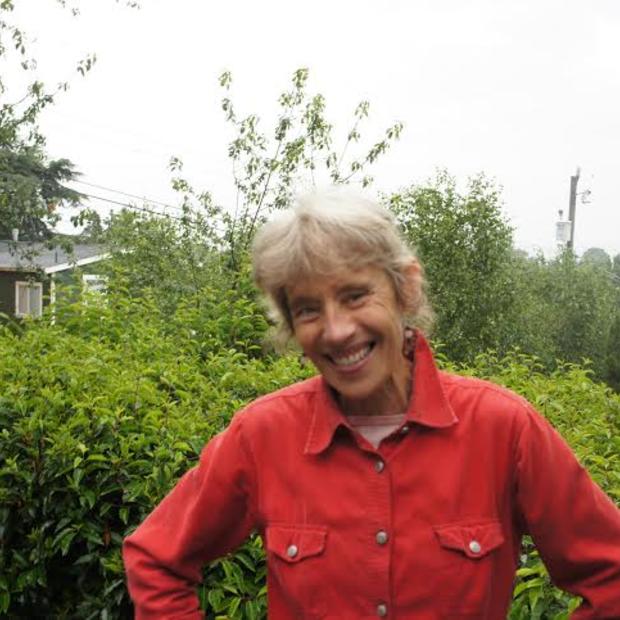Walk down to the docks at Friday Harbor Labs on San Juan Island and you’ll find a row of space-age domes. They may provide a window into the future, say scientists. Not of space travel, but of the effects of increasingly acidic oceans on phytoplankton, the micro-organisms at the base of the food web.
Click on the audio player above or here to listen.
The coastal waters at this University of Washington facility are perfect testing grounds. CO2 levels are almost double those in the atmosphere. Highly acidic waters are known to impact the ability of shell-forming animals such as corals, oysters and urchins to grow. But what does it mean for phytoplankton?
“Phytoplankton are one of the first responders to increases in CO2 because they use an element of CO2 to fix carbon into biomass via photosynthesis. That sets off a whole cascade in the microbial food web,” says Robin Kodner, a research scientist at Friday Harbor Labs and an Assistant Professor of biology at Western Washington University. When plankton bloom, she explains, so do bacteria and then tiny grazers called micro-heterotrophs that are consumed by fish up the food chain.
The team of scientists and students involved in the experiment are looking at phytoplankton, zooplankton, viruses and bacteria to see how they adapt. Control domes hold seawater with current CO2 levels in the area, 650 parts per million. Others have been treated with almost double that level, 1200 parts per million.
Andrew Baird, an undergrad, samples for dissolved oxygen. “With the oxygen and the carbon measurements, we can tease out what the production is doing and what the biology is actually doing,” he explains.
The biology or life in the seawater is complex and measuring its response to increased CO2 is even more so. Nutrients in the water, the amount of dissolved inorganic carbon and alkalinity are also sampled.
Now in its third year, tweaks in the experiment are still being ironed out. This year, the domes were enclosed in mesh bags to cut down light by 50 percent. Less light means plankton won’t bloom as rapidly and obscure everything else happening in the domes.
James Murray, an oceanography professor, helped design the study. “We were just looking at some light data in the lab from the last few days and it looks like we’ve lowered the light considerably more than that,” he says. Light and nutrients drive biology, he explains and “By slowing down the biology, what we hope to see is some impact of the different CO2 levels we couldn’t see before.”
A state-of-the-art chemistry lab is critical to interpreting the study. Up and running for a year and a half, the lab is home to a host of studies, including one manipulating the chemistry of oysters.
Michael O-Donnell, a post-doc participant in the phytoplankton study, is also studying how high CO2 impacts mussels. He shows off small glass chambers pulsing with recirculating pumps and electrodes. “So, we can control the amount of carbon dioxide in the water and we can control the temperature and that lets us put organisms in them for periods of days to months, depending on how much work we want to put in, and let them grow up and look at how they’re responding to changing environmental conditions.”
What makes the data tricky to interpret, says O-Donnell, is that ocean CO2 isn’t just coming from burning fossil fuels, but from the organisms themselves. When grazing micro-organisms eat organic carbon, they turn it into carbon dioxide and water, and use up oxygen. Changes in CO2, nutrients, pH and temperature all affect the ecosystem. "If it’s sunny carbon levels will drop as algae photosynthesize, then when it is dark, the grazers eat the carbon and make CO2 again.” Increased CO2 will make more carbon available for photosynthesis.
Robin Kodner, the research scientist who studies phytoplankton community response to environmental change, says the experiment is really about manipulating a complex system and observing how it reacts. “Our hypothesis is very general. That means we expect the community to respond to our changes. And in that case we would expect to see a difference in our high CO2 domes versus the control domes.”
Exactly how it will respond isn’t entirely clear. But there are some new observations, says Kodner. Plankton not often seen in coastal waters are showing up in the control domes. “We’re seeing all these little flagellates that might have something to do with our experimental conditions.” Flagellates are non-photosynthesizing plankton with whip like appendages. “It’s really too soon to tell. But the dynamics of the phytoplankton are a bit different this year, which is exciting and what we wanted to see happen.”
Back in the biology labs, students filter seawater to concentrate it and collect the cells. “Turn this pump on. Then open these little valves and the water is going to go through and catch everything on the filter.” They have no time to spare. Two hundred and seven different samples were collected this morning alone. Tomorrow they’ll collect hundreds more.



